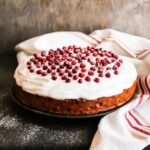Are you looking to elevate the look of your cakes and pastries? One of the key tools you’ll need is a piping bag.
In this article, we will explore the art of cake decorating using a piping bag, and how it can take your creations to the next level. From choosing the right types of piping bags and tips to mastering basic and advanced techniques, we’ve got everything you need to know to become a pro at cake decorating.
Using a piping bag is more than just a way to apply frosting or icing – it’s a versatile tool that can help you create stunning designs and intricate details on your cakes. Whether you’re a beginner or an experienced baker, understanding the different techniques and tips for using a piping bag can make all the difference in achieving professional-looking results.
In this comprehensive guide, we will cover everything from selecting the right type of piping bags and tips, filling and handling them properly, as well as troubleshooting common issues that may arise during cake decorating. We’ll also provide you with practical tips for practicing your piping skills before applying them to your actual cakes. So let’s get started on our journey to mastering the art of cake decoration with a piping bag.
Types of Piping Bags
When it comes to cake decorating, the type of piping bag you use can make a big difference in the outcome of your design. There are various types of piping bags available in the market, each with its own advantages and purposes.
Disposable Bags
Disposable piping bags are a popular choice for many bakers due to their convenience. These bags are made of thin, flexible plastic and can be easily disposed of after use, making clean-up a breeze. They are also convenient for using multiple colors of frosting without the need to wash and switch out reusable bags.
Reusable Bags
On the other hand, reusable piping bags are made of thicker, more durable material such as nylon or canvas. They are a more eco-friendly option as they can be washed and used multiple times, reducing waste. Reusable bags are also great for piping large quantities of frosting or icing as they can withstand more pressure without bursting.
Silicone Bags
Silicone piping bags have gained popularity in recent years due to their durability and flexibility. These bags are easy to clean and can be used with both hot and cold fillings. Some silicone bags also come with interchangeable tips, making them versatile for different designs.
Choosing the right type of piping bag ultimately depends on personal preference, budget, and specific needs for cake decorating. Whether you opt for disposable, reusuable, or silicone piping bags, each type offers its own set of benefits to help you achieve beautifully decorated cakes.
Choosing the Right Tip
When it comes to cake decorating with a piping bag, choosing the right tip is crucial in achieving various designs and effects on the cake. There are different types of piping tips available in the market, each serving a specific purpose in creating beautiful and intricate decorations. The choice of tip can elevate the overall look of the cake and add a personalized touch to the design.
One of the most common types of piping tips is the round tip, which is perfect for creating outlines, writing messages, or adding simple dots and beads to the cake. For more intricate designs such as flowers and petals, a petal tip can be used to achieve a delicate and realistic floral effect. Additionally, star tips are ideal for creating rosettes, shells, borders, and even filling in large areas with frosting.
It’s also important to consider the size of the piping tip, as larger tips are best suited for covering large areas or creating bold designs, while smaller tips are perfect for adding fine details and intricate patterns. By understanding the different types of piping tips and their specific purposes, cake decorators can have more creative freedom in designing their cakes and achieving professional-looking results.
Filling the Piping Bag
Step-by-Step Guide
Filling a piping bag may seem like a simple task, but there are techniques that can help ensure you do it correctly. Start by fitting a piping tip into the coupler and trimming the end of the bag. This will allow the tip to fit snugly and prevent any frosting from leaking out of the top. Once the bag is ready, place it in a tall glass or container with its edges folded over to hold it in place.
Next, carefully spoon or scoop your frosting into the piping bag, being sure not to overfill it. Leaving too much air inside can cause air bubbles while squeezing out frosting later on. Twist and squeeze the open end of the bag closed, then apply pressure to push all the frosting towards the tip.
Techniques for Filling Multiple Colors
If you want to decorate with multiple colors, there are a few different methods you can use. One technique involves separating your frosting into separate bowls and then gently layering them on top of each other inside one piping bag. This method creates a beautiful swirled effect when piped onto the cake.
Another approach is using plastic wrap or parchment paper to create “stripes” of different colored frosting within one bag. By piping stripes onto plastic wrap and rolling them together before inserting them into the bag, you can achieve a multi-colored effect without mixing all your frostings together before they reach the tip.
By mastering these filling techniques, you’ll be able to elevate your cake decorating skills and create stunning designs with ease.
Basic Piping Techniques
Cake decorating with a piping bag can seem intimidating at first, but mastering the basic piping techniques is essential for creating beautifully decorated cakes. One of the most common techniques is outlining, which involves using a thin, round tip to create borders and define shapes on the cake. This technique provides a guideline for more intricate designs and prevents frosting from spilling over the edges of the cake.
Another fundamental piping technique is flooding, which entails using a slightly thinned-out frosting or icing to fill in the outlined areas on the cake. This creates a smooth and polished look, especially when using multiple colors to create beautiful patterns and designs.
Furthermore, creating rosettes, shells, and leaves are also basic piping techniques that can add dimension and texture to the cake’s design. Rosettes are formed by applying consistent pressure while swirling the piping bag in a circular motion, resulting in delicate floral shapes.
Shells, on the other hand, are made by squeezing the piping bag while moving it back and forth to form shell-like patterns. Lastly, leaves are achieved by employing varying pressure on the piping bag and using leaf-shaped tips to create realistic foliage.
Understanding these basic piping techniques is crucial for any aspiring cake decorator. With practice and patience, achieving flawless results with these foundational skills will undoubtedly elevate your cake decorating game.
| Basic Piping Techniques | Details |
|---|---|
| Outlining | Create borders and define shapes on the cake |
| Flooding | Fill in outlined areas with slightly thinned-out frosting or icing |
| Rosettes, Shells, Leaves | Add dimension and texture to the cake’s design through various piped shapes |
Advanced Piping Techniques
Once you have mastered the basic piping techniques, you can move on to more advanced designs that will take your cake decorating skills to the next level. One popular technique is the basketweave, which creates a woven pattern that adds texture and visual interest to the cake. To achieve this look, use a flat or basketweave piping tip and pipe alternating vertical and horizontal lines, then fill in the gaps with a different color for a striking effect.
Another advanced piping technique is creating ruffles, which add a delicate and elegant touch to any cake design. To create ruffles, use a petal or leaf piping tip and gently pipe overlapping layers of frosting in a back-and-forth motion, starting from the bottom of the cake and working your way up. This technique requires precision and patience but produces beautiful results.
For those looking to add intricate details to their cakes, lace patterns are an excellent choice. There are lace-patterned piping tips available that make it easier to create these delicate designs. Simply pipe the lace pattern onto parchment paper, allow it to dry completely, then carefully transfer it onto the cake for a stunning and professional-looking finish.
Mastering these advanced piping techniques may take some practice, but the results are well worth the effort. With patience and dedication, you can achieve beautifully decorated cakes that will impress your friends and family.
| Advanced Piping Technique | Description |
|---|---|
| Basketweave | Creates a woven pattern using vertical and horizontal lines filled with different colors. |
| Ruffles | Adds a delicate touch with overlapping layers of frosting piped in a back-and-forth motion. |
| Lace Patterns | Delicate designs achieved by piping onto parchment paper and transferring onto the cake. |
Troubleshooting
When using a piping bag for cake decorating, there are some common issues that may arise. Here are some troubleshooting tips to help you address these problems:
- Air Bubbles: If you notice air bubbles in your icing or frosting while decorating the cake, try gently tapping the filled piping bag on the counter to release any trapped air. Another technique is to carefully twist the top of the piping bag to push any air bubbles towards the tip before piping.
- Inconsistent Piping: Inconsistent piping can be frustrating, but it can be addressed by practicing consistent pressure while squeezing the piping bag. Additionally, make sure to hold the piping bag at a consistent angle and maintain steady hand movements for even lines and designs.
- Frosting Consistency: The consistency of your frosting plays a crucial role in successful cake decorating. If your frosting is too thick and difficult to pipe, try adding a small amount of milk or water to thin it out. On the other hand, if your frosting is too runny and does not hold its shape when piped, add more powdered sugar to thicken it.
By addressing these common issues and following these troubleshooting tips, you can enhance your cake decorating skills with a piping bag and achieve professional-looking results. Remember that practice makes perfect, so don’t be discouraged if you encounter these issues initially – keep practicing and experimenting with different techniques to improve your cake decorating abilities.
Practice Tips and Tricks
Mastering the art of cake decorating with a piping bag takes practice and patience. One helpful tip for practicing piping techniques is to use parchment paper as a practice surface before attempting to decorate an actual cake. This allows you to get a feel for the pressure and angle needed to create different designs without the added pressure of decorating a cake.
Additionally, it’s important to practice on a flat surface before moving on to decorating the actual cake. This helps in getting used to the flow of frosting or icing through the piping bag and allows for better control over the design. By practicing on a flat surface, decorators can also experiment with different piping tips and techniques without the fear of ruining a cake.
Another useful tip for practicing piping techniques is to start with simple designs and gradually work your way up to more intricate patterns. This gradual progression will help build confidence and skill in using the piping bag, leading to more professional-looking results when decorating cakes. With consistent practice and perseverance, decorators can enhance their piping skills and create visually stunning cakes that are sure to impress.
Conclusion
In conclusion, mastering the art of decorating cakes with a piping bag can truly elevate the overall look of your baked creations. From choosing the right type of piping bag to selecting the perfect tip for creating intricate designs, this article has provided a comprehensive guide to help you improve your cake decorating skills. By practicing basic and advanced piping techniques, you can take your cake decorating to the next level and impress friends and family with professional-looking results.
Remember, choosing the right piping bag and tip is crucial for achieving the desired frosting designs on your cakes. Whether you opt for disposable bags for convenience or invest in reusable or silicone bags for sustainability, there are various options available to suit your needs.
Additionally, understanding how to fill the piping bag properly and mastering different piping techniques such as outlining, flooding, rosettes, shells, leaves, basketweave, ruffles, and lace patterns will give you the confidence to create beautiful and intricate designs on your cakes.
Lastly, don’t be discouraged by any initial challenges you may face when practicing cake decorating with a piping bag. It’s important to remember that practice makes perfect, so don’t hesitate to experiment with different techniques and learn from any troubleshooting issues that may arise.
With dedication and patience, you’ll soon become proficient in using a piping bag to decorate cakes and impress everyone with your newfound skills. So go ahead and try out different piping techniques to enhance your cake decorating abilities – it’s all about having fun while creating delicious works of art.
Frequently Asked Questions
How Do You Decorate a Cake With Piping Bag and Tips?
Decorating a cake with a piping bag and tips involves filling the bag with frosting, selecting the desired piping tip, and then using steady pressure to pipe the frosting onto the cake in various designs. It’s important to hold the bag at the proper angle and distance from the cake to create even and consistent decorations.
Practice and patience are key when learning how to use a piping bag for cake decorating.
What Are the Best Piping Tips for Cake Decorating?
The best piping tips for cake decorating depend on the specific design or effect you want to achieve. Round tips are great for creating lines, dots, and writing, while star tips can produce beautiful rosettes or borders.
Leaf tips are perfect for adding foliage details, and petal tips are ideal for making flower petals. It’s helpful to have a variety of tips in different sizes and shapes to accommodate different decorating needs.
What Is the Easiest Way to Put Frosting in a Piping Bag?
The easiest way to put frosting in a piping bag is by using a spatula or spoon to transfer the frosting into the bag without making a mess. A common method is to fold down the top of the piping bag to create a cuff before spooning in the frosting, then unfolding the cuff once it’s filled.
Another approach is using a large glass or pitcher to hold open the bag while filling it with frosting from either a bowl or another piping bag fitted with a larger tip. Whichever method you choose, keeping the top of the bag clean will make it easier to seal and squeeze out frosting cleanly.

Welcome to my blog about home and family. This blog is a place where I will share my thoughts, ideas, and experiences related to these important topics. I am a stay-at-home mom with two young children. I hope you enjoy reading it! and may find some helpful tips and ideas that will make your home and family life even better!





